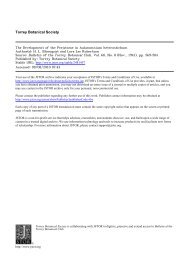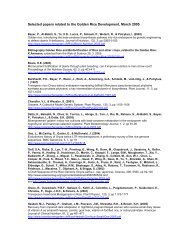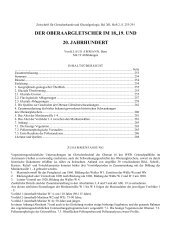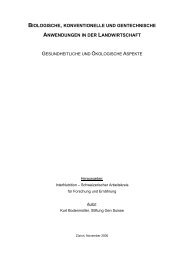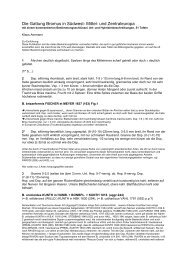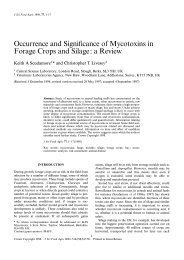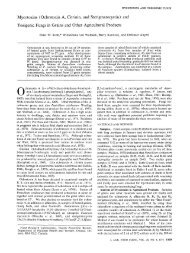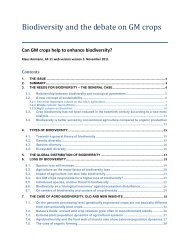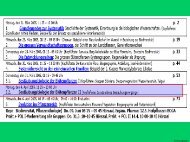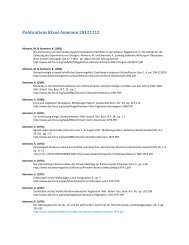Genetic engineering of plants to enhance resistance to fungal ...
Genetic engineering of plants to enhance resistance to fungal ...
Genetic engineering of plants to enhance resistance to fungal ...
You also want an ePaper? Increase the reach of your titles
YUMPU automatically turns print PDFs into web optimized ePapers that Google loves.
Punja: genetic <strong>engineering</strong> / <strong>fungal</strong> disease <strong>resistance</strong> 229<br />
<strong>of</strong> selection forces, such as highly specific fungicides, major<br />
disease <strong>resistance</strong> genes, and environmental fac<strong>to</strong>rs. The<br />
selection imposed by antimicrobial proteins, for example,<br />
could force the evolution <strong>of</strong> adaptive strategies in the pathogen<br />
<strong>to</strong> defend against the inhibi<strong>to</strong>ry compounds. Such a coevolution<br />
has been proposed for chitinases (Bishop et al.<br />
2000), in which adaptive functional modifications <strong>of</strong> the enzyme<br />
active site have occurred. Similarly, changes in sensitivity<br />
<strong>of</strong> pathogens <strong>to</strong> antimicrobial proteins overexpressed<br />
in transgenic <strong>plants</strong> could be selected. The use <strong>of</strong> combined<br />
genes that target different sites could reduce the selection<br />
pressure imposed on the pathogen. <strong>Genetic</strong>ally engineered<br />
<strong>plants</strong> with successfully <strong>enhance</strong>d disease <strong>resistance</strong> should<br />
not be viewed as a panacea and continual moni<strong>to</strong>ring for<br />
unexpected events will be necessary.<br />
Future prospects<br />
The tremendous scientific progress made since 1991 in<br />
genetic <strong>engineering</strong> <strong>of</strong> <strong>plants</strong> for <strong>enhance</strong>d <strong>resistance</strong> <strong>to</strong><br />
<strong>fungal</strong> pathogens as described in this paper is an indication<br />
<strong>of</strong> the high level <strong>of</strong> interest in the scientific community on<br />
this subject. As the technology evolves <strong>to</strong>ward the use <strong>of</strong><br />
tissue-specific or pathogen-inducible promoters, the expression<br />
<strong>of</strong> engineered traits that are effective against a broad<br />
range <strong>of</strong> pathogens, and the utilization <strong>of</strong> synthetically derived<br />
peptides and <strong>of</strong> R genes, the impact on disease management<br />
will be <strong>enhance</strong>d. Evaluation <strong>of</strong> these transgenic<br />
<strong>plants</strong> for response <strong>to</strong> disease will need <strong>to</strong> be extended <strong>to</strong><br />
field trials and appropriate agronomic data collected <strong>to</strong> ensure<br />
that this technology can be successfully implemented<br />
in farmer’s fields <strong>to</strong> augment on-going disease management<br />
practices. Transgenic <strong>plants</strong> with <strong>enhance</strong>d disease <strong>resistance</strong><br />
can become a valuable component <strong>of</strong> a disease management<br />
program in the future.<br />
Acknowledgements<br />
I thank The Canadian Phy<strong>to</strong>pathological Society for the<br />
opportunity <strong>to</strong> prepare this paper as the Past-president’s<br />
contribution, W.P. Chen for bringing <strong>to</strong> my attention relevant<br />
research articles, M. Nguyen for typing the manuscript,<br />
and the Natural Sciences and Engineering Research Council<br />
<strong>of</strong> Canada for their continued financial support.<br />
References<br />
Abad, M.S., Hakimi, S.M., Kaniewski, W.K., Rommens, C.M.,<br />
Shulaev, V., Lam, E., and Shah, D.M. 1997. Characterization <strong>of</strong><br />
acquired <strong>resistance</strong> in lesion-mimic transgenic pota<strong>to</strong> expressing<br />
bacterio-opsin. Mol. Plant–Microbe Interact. 10: 635–645.<br />
Agrios, G.N. 1997. Plant pathology. 4th ed. Academic Press, New<br />
York.<br />
Alexander, D., Goodman, R.M., Gut-Rella, M., Glascock, C.,<br />
Weymann, K., Friedrich, L., Maddox, D., Ahl-Goy, P., Luntz,<br />
T., Ward, E., and Ryals, J.A. 1993. Increased <strong>to</strong>lerance <strong>to</strong> two<br />
oomycete pathogens in transgenic <strong>to</strong>bacco expressing<br />
pathogenesis-related protein 1a. Proc. Natl. Acad. Sci. U.S.A.<br />
90: 7327–7331.<br />
Asao, H., Nishizawa, Y., Arai, S., Sa<strong>to</strong>, T., Hirai, M., Yoshida, K.,<br />
Shinmyo, A., and Hibi, T. 1997. Enhanced <strong>resistance</strong> against a<br />
<strong>fungal</strong> pathogen Sphaerotheca humuli in transgenic strawberry<br />
expressing a rice chitinase gene. Plant Biotechnol. 14: 145–149.<br />
Baker, C.J., and Orlandi, E.W. 1995. Active oxygen in plant<br />
pathogenesis. Annu. Rev. Phy<strong>to</strong>pathol. 33: 299–322.<br />
Baker, B., Zambryski, P., Staskawicz, B., and Dinesh-Kumar, S.P.<br />
1997. Signalling in plant–microbe interactions. Science (Washing<strong>to</strong>n,<br />
D.C.), 276: 726–733.<br />
Barker, S.J., and Tagu, D. 2000. The roles <strong>of</strong> auxins and<br />
cy<strong>to</strong>kinins in mycorrhizal symbioses. J. Plant Growth Regul.<br />
19: 144–154.<br />
Bar<strong>to</strong>n, J.E., and Dracup, M. 2000. <strong>Genetic</strong>ally modified crops<br />
and the environment. Agron. J. 92: 797–803.<br />
Beffa, R.S., H<strong>of</strong>er, R.-M., Thomas, M., and Meins, F., Jr. 1996.<br />
Decreased susceptibility <strong>to</strong> viral disease <strong>of</strong> β-1,3-glucanasedeficient<br />
<strong>plants</strong> generated by antisense transformation. Plant<br />
Cell, 8: 1001–1011.<br />
Bent, A. 1996. Plant disease <strong>resistance</strong> genes: function meets<br />
structure. Plant Cell, 8: 1757–1771.<br />
Berna, A., and Bernier, F. 1997. Regulated expression <strong>of</strong> a wheat<br />
germin gene in <strong>to</strong>bacco: oxalate oxidase activity and apoplastic<br />
localization <strong>of</strong> the heterologous protein. Plant Mol. Biol. 33:<br />
417–429.<br />
Bettini, P., Cosi, E., Pellegrini, M.G., Turbanti, L., Vendramin,<br />
G.G., and Buiatti, M. 1998. Modification <strong>of</strong> competence for in<br />
vitro response <strong>to</strong> Fusarium oxysporum in <strong>to</strong>ma<strong>to</strong> cells. 3. PRprotein<br />
gene expression and ethylene evolution in <strong>to</strong>ma<strong>to</strong> cell<br />
lines transgenic for phy<strong>to</strong>hormone-related bacterial genes.<br />
Theor. Appl. Genet. 97: 575–583.<br />
Bi, Y.-M., Cammue, B.P.A., Goodwin, P.H., Krishna Raj, S., and<br />
Saxena, P.K. 1999. Resistance <strong>of</strong> Botrytis cinerea in scented geranium<br />
transformed with a gene encoding the antimicrobial<br />
protein Ace-AmP1. Plant Cell Rep. 18: 835–840.<br />
Bieri, S., Potrykus, I., and Fütterer, J. 2000. Expression <strong>of</strong> active<br />
barley seed ribosome-inactivating protein in transgenic wheat.<br />
Theor. Appl. Genet. 100: 755–763.<br />
Bishop, J.G., Dean, A.M., and Mitchell-Olds, T. 2000. Rapid evolution<br />
in plant chitinases: molecular targets <strong>of</strong> selection in<br />
plant–pathogen coevolution. Proc. Natl. Acad. Sci. U.S.A. 97:<br />
5322–5327.<br />
Bliffeld, M., Mundy, J., Potrykus, I., and Fütterer, J. 1999. <strong>Genetic</strong><br />
<strong>engineering</strong> <strong>of</strong> wheat for increased <strong>resistance</strong> <strong>to</strong> powdery<br />
mildew disease. Theor. Appl. Genet. 98: 1079–1086.<br />
Bohlmann, H. 1994. The role <strong>of</strong> thionins in plant protection. Crit.<br />
Rev. Plant Sci. 13: 1–16.<br />
Bolar, J.P., Norelli, J.L., Wong, K.-W., Hayes, C.K., Harman, G.E.,<br />
and Aldwinckle, H.S. 2000. Expression <strong>of</strong> endochitinase from<br />
Trichoderma harzianum in transgenic apple increases <strong>resistance</strong><br />
<strong>to</strong> apple scab and reduces vigor. Phy<strong>to</strong>pathology, 90: 72–77.<br />
Boller, T. 1993. Antimicrobial functions <strong>of</strong> the plant hydrolases,<br />
chitinases and β-1,3-glucanases. In Mechanisms <strong>of</strong> plant defense<br />
responses. Edited by B. Fritig and M. Legrand. Kluwer<br />
Academic Press, Dordrecht. pp. 391–400.<br />
Brisson, L.F., Tenhaken, R., and Lamb, C.J. 1994. Function <strong>of</strong> oxidative<br />
cross-linking <strong>of</strong> cell wall structural proteins in plant disease<br />
<strong>resistance</strong>. Plant Cell, 6: 1703–1712.<br />
Broekaert, W.F., Terras, F.R.G., Cammue, B.P.A., and Osborn,<br />
R.W. 1995. Plant defensins: novel antimicrobial peptides as<br />
components <strong>of</strong> the host defense system. Plant Physiol. 108:<br />
1353–1358.<br />
Broekaert, W.F., Cammue, B.P.A., De Bolle, M.F.C., Thevissen,<br />
K., De Samblanx, G.W., and Osborn, R.W. 1997. Antimicrobial<br />
peptides from <strong>plants</strong>. Crit. Rev. Plant Sci. 16: 297–323.<br />
Broglie, K., Chet, I., Holliday, M., Cressman, R., Biddle, P.,<br />
Knowl<strong>to</strong>n, S., Mauvais, C.J., and Broglie, R. 1991. Transgenic



